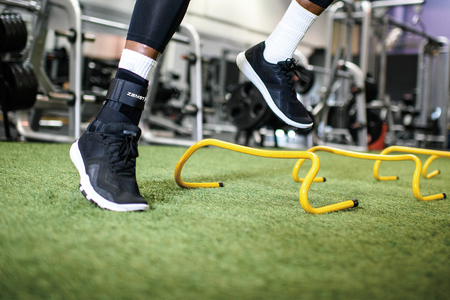When it comes to protecting your ankles during high-impact sports like volleyball, choosing the right volleyball ankle brace can make a significant difference in preventing injuries and providing support. There are two common types of ankle braces: Strap braces and Lace-up braces. Both offer unique benefits, but which is better?
Understanding Ankle Sprains and Ankle Support
Ankle sprains are one of the most common injuries in volleyball, often occurring when a player lands awkwardly, comes down on someone’s foot, or rolls their ankle moving around the court.
In a 2017 review on volleyball injuries, ankle sprains were by far the most common injury for volleyball players at 31.9%1. Ankle braces play a crucial role in reducing the risk of sprains by providing stability and limiting excessive movement. While various types of ankle braces are available, the debate between strap braces and lace-up braces often revolves around comfort, adjustability, and overall support.
Strap Ankle Braces
Strap braces, as the name suggests, use Velcro straps to secure the brace around the ankle. This type of ankle brace is typically designed with a figure-eight strap system that mimics traditional taping techniques. Here are some pros and cons when choosing a strap brace:
Pros for Strap Braces
- Ease of Use and Adjustability: Strap braces are relatively easy to put on and take off. The Velcro straps allow for quick adjustments, making them ideal for players who need to don and doff the brace quickly. Strap braces offer a high degree of adjustability, allowing users to customize the tightness and support based on their preferences.
- Range of Motion: Strap braces typically offer a bit more freedom of movement compared to lace-up braces. Even with the freedom it can offer three-way support (anterior, medial and lateral) with the strap.
Cons for Strap Braces
- Less Rigid Support: If the strap brace does not have protective guards on the sides (medial and lateral) then strap braces generally provide less rigid support compared to lace-up braces. While they can be effective in preventing mild to moderate ankle sprains, they may not be suitable for more severe cases.
- Wear and Tear: The Velcro straps can wear out over time, affecting the brace’s overall effectiveness. This may require periodic replacement or adjustment.
Lace-Up Ankle Braces
Lace-up ankle braces function similarly to high-top sneakers, with a lacing system that wraps around the ankle. This type of brace is known for its secure fit and added stability.
Pros for Lace-Up Braces
- Firm Support: Lace-up braces offer a more rigid structure, providing strong support to the ankle joint. This makes them ideal for players with a history of severe ankle sprains or those requiring extra stability.
- Customizable Fit: The lacing system allows for a customized fit, ensuring that the brace stays securely in place during intense activity. This reduces the risk of the brace slipping or becoming loose during play.
- Durability: Lace-up braces are generally more durable than strap braces, with fewer points of wear and tear. This makes them a longer-lasting investment for players who use ankle braces regularly.
Cons for Lace-Up Braces
- Complexity: Lace-up braces can be more complex to put on and adjust, requiring more time to achieve the desired fit. This can be a drawback for players who need a quick setup.
- Limited Flexibility: Due to their rigid structure, lace-up braces may limit the range of motion more than strap braces. This could be a consideration for players who require greater agility.
- A 2011 study found that lace-up ankle braces reduced the incidence but not the severity of acute ankle sprains.2
Which Is Better?
The choice between strap braces and lace-up braces ultimately depends on your individual needs and preferences.
If you value ease of use, adjustability, and a more flexible range of motion, strap braces might be the better choice. On the other hand, if you need firm support, durability, and a secure fit, lace-up braces could be the way to go.
Zamst offers a variety of ankle braces to meet your needs and preferences.
The A1 ankle braces provide a balance of moderate support and comfort, designed with easy application. The three adjustable straps and internal stabilizers on the sides provide strength and stability without limiting mobility.
For other ankle brace lineup, explore Zamst ankle collections page.
Consider your history with ankle sprains, your playing style, and the level of support you need. If you’re unsure, consulting with a coach, trainer, or medical professional can help you make an informed decision.
Both strap braces and lace-up braces can offer significant benefits for volleyball players. By choosing the right brace and using it consistently, you can reduce the risk of ankle sprains and stay on top of your game.
1.Reitmayer, Hans-Eric. “A review on volleyball injuries” Timisoara Physical Education and Rehabilitation Journal, vol.10, no.19, 2017, pp.189-194.
2. McGuine TA, Brooks A, Hetzel S. The Effect of Lace-up Ankle Braces on Injury Rates in High School Basketball Players. The American Journal of Sports Medicine. 2011;39(9):1840-1848. doi:10.1177/0363546511406242
ABOUT THE AUTHOR
EVAN JEFFRIES is a physical therapist with a Doctorate in Physical Therapy (DPT) from the University of St. Augustine for Health Sciences. He is also the owner of Evolving Motion Physical Therapy and has vast knowledge of the musculoskeletal system and has treated many orthopedic conditions by bringing a proactive approach to healthcare and lifestyle. Recently he has also been active on social media as an injury analyst mainly in related to injuries NBA players have sustained. Evan can be followed on his social media accounts.









